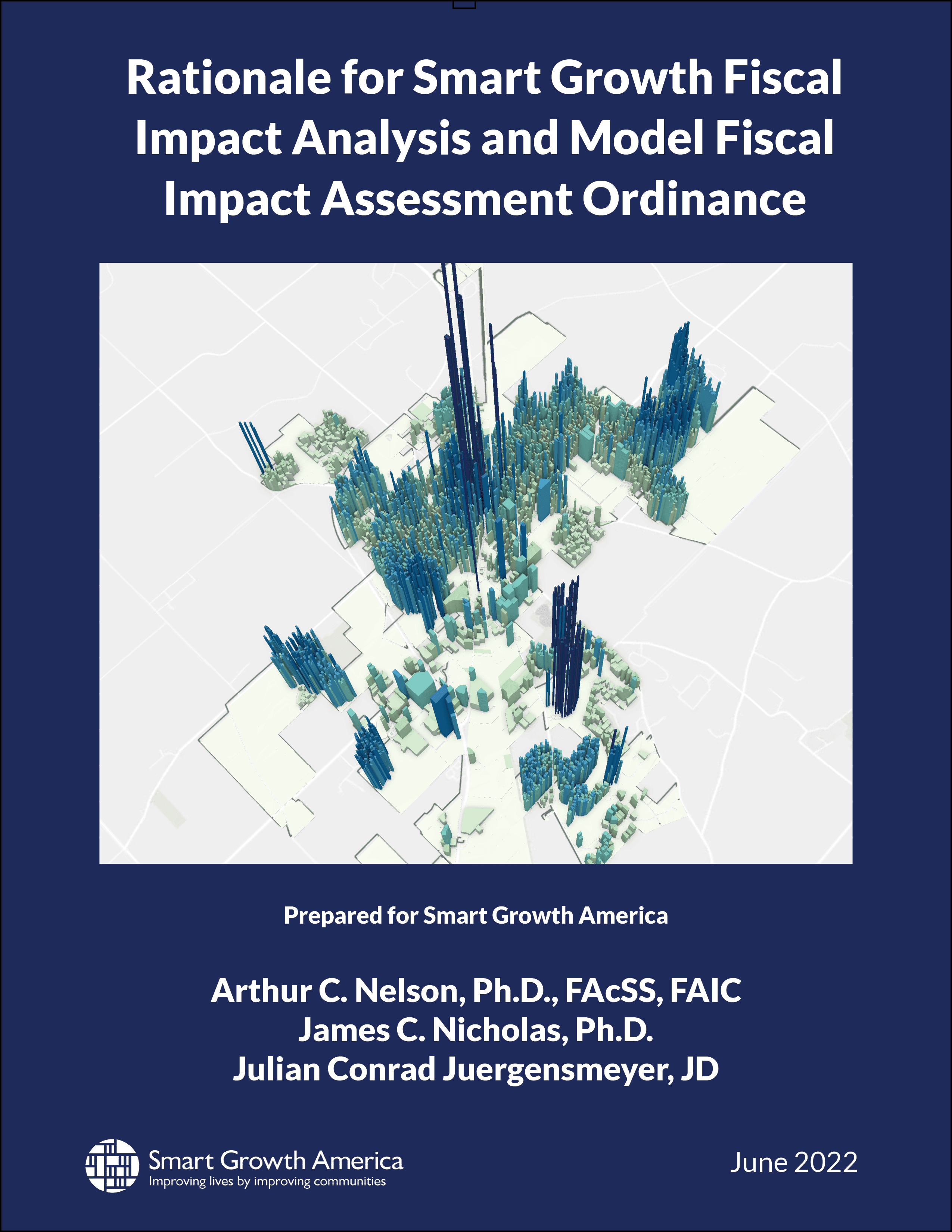
News
By Helen Hope, June 27, 2022
Leaders of every community—big metropolis and small town alike—strive to foster economic growth and prosperity. Regardless of party or ideology, every elected official prefers the choice of lowering taxes or increasing services compared to the reverse. A growing economy and tax base make that easier to achieve, and so most local policies are intended to encourage new development—but where the new development happens matters as much or more than having new development at all. Smart Growth America commissioned Arthur C. Nelson, James C. Nicholas, and Julian Conrad Juergensmeyer to build the rationale for fiscal impact analysis and to create a guide that can show municipalities the vital connections between land use and the cost of government services and tax revenues from new development.
From an economic and fiscal perspective, new development projects are generally seen as desirable: bringing new jobs, residents, and incomes into the community, and enhancing the tax base. This perspective often leads to the view that any development is good, anywhere. It may incline local officials to approve, and indeed incentivize, any development proposal that comes along. This new development—shops, offices, homes—are connected to public utility infrastructure (think water, sewer, storm drains, police, fire, school buses, and trash collection whose spatial distribution drives costs), often at taxpayer expense.
Often, local officials are prone to pursue annexation of land surrounding the city, on the assumption that more land = more people = larger tax base = improved long-term fiscal health of their city. But that assumption is wrong. It turns out that where and how growth occurs matters in terms of “net fiscal impact”: the difference between the tax revenues generated by new development and the government’s costs of providing the infrastructure and services that it will demand. There is a vital connection between how land is used and the cost of government services, as well as the tax revenues that are generated. Whether a community reaps the benefits from a positive net fiscal impact (tax revenues remaining higher than infrastructure costs) from new development can depend significantly on the development pattern that results from the land use decisions made by local governments.
However, the land use decisions—things like zoning ordinances, tax policies, capital budget practices, and one-off exceptions—often don’t consider how they will impact development patterns, and ultimately how those development patterns will affect government finances like the net fiscal impact mentioned before. The new Rationale for Smart Growth Fiscal Impact Analysis and Model Fiscal Impact Assessment Ordinance guide is intended to help explain how to incorporate these conversations into government and development planning.
Okay, so why does this matter?
Providing infrastructure to low-density, sprawling development costs more than for compact, denser developments. Building in the latter can reduce taxpayer burdens, allowing them to save money that can be reinvested in ways that can improve the local economy. There are obviously many factors that affect local revenues and the cost of government services. Often these are out of the hands of local officials: recessions, natural disasters, international markets, state legislatures, and on and on.
Land use decisions, however, are key policy levers for local governments—it’s something they control, and allows them to guide the policy process to encourage sound fiscal decisions in new development. Even with that special autonomy, the fiscal impact of those decisions is not routinely considered as part of the process. By recognizing the relationship between the nature and location of development and government revenues and costs, and adopting an appropriate fiscal analysis policy, local officials can improve their community’s long-term fiscal sustainability.
Broadly, a fiscal impact analysis policy is a policy adopted by a unit of government that requires that new development be analyzed to calculate its near- and long-term impacts on local government costs and revenues. Smart Growth America’s fiscal modeling technique helps governments understand the varying financial performance of alternative development patterns, and to inform the strategies they can use to generate better net returns in the future.
Read a more detailed, wonkier description of fiscal impact analysis here
But how does it all work?
The impact of a community’s development pattern on local fiscal systems varies with the number of taxpayers among whom costs can be spread—a block with a row of townhouses, say 40 units, does not require 10 times the infrastructure as the same block with 4 houses on large lots. On the other hand, revenue generated per acre is significantly higher on a denser block. These impacts can be divided into the effects on revenue generation and on costs:
1. Areas that are denser, mixed-use, and walkable produce substantially higher tax dollars per acre than those that are dispersed, single-use, and car-dependent. Revenue generation is very uneven in spatial terms.
2. The cost of providing infrastructure and municipal services to areas that are denser, mixed-use, and walkable is significantly lower than that of areas that are single-use and car-dependent.
These impacts have been understood by economists and planners for decades, but are not generally incorporated into government policy at any level. By evaluating the use of land and new development based on its impact to municipal budgets, local leaders can improve their community’s bottom line and make sound fiscal decisions about how to grow.
Related News

© 2025 Smart Growth America. All rights reserved
Site By3Lane Marketing










